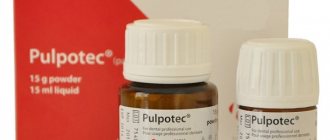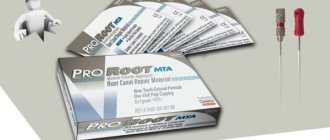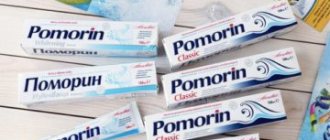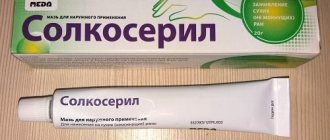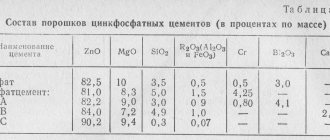2735
Among the variety of dental preparations, I often want to understand in more detail the differences and practical purposes of each, especially when there are many analogues.
The goal of a self-respecting dentist is to choose the most effective, appropriate composition for a specific situation.
Among the latest developments among materials for temporary filling of dental canals, Metapaste deserves special attention.
General overview
The drug is available in the form of a white paste, which has a medium consistency and is easily introduced into the cavity.
The substance is packaged in plastic syringes and is completely ready for use for filling. This product is produced in Korea.
When exposed, a bactericidal treatment is carried out, since the active components come into contact with the microflora of the oral cavity and completely destroy pathogenic microorganisms.
The effect begins 5 minutes after administration, and after 48 hours the treated cavity becomes completely sterile.
The kit, in addition to a syringe for 2.2 grams of the substance , includes plastic tips, each of which is intended for single use. Also included in the package is a ring with a rotating design , which allows you to adjust the direction of the tip when fixing it.
With the help of such a system, the introduction of paste into the tissues located around the tooth apex is made as quick and simple as possible; if necessary, the material can be removed.
One package allows you to fill up to 75 tooth canals with paste that require treatment for infection. The composition includes the following components:
- Calcium hydroxide.
- Barium sulfate.
Main advantages of the drug
"Metapex" has a long-lasting bactericidal effect, which is achieved due to pH 12.5. 48 hours after administration of the drug, up to 99% of microorganisms located in the root canal die. The antibacterial component - iodoform - destroys Gram-positive pathogens, staphylococci, streptococci, fungi and viruses. It eliminates the appearance of secondary inflammation even with complications in the form of cysts of various origins.
The paste-like consistency ensures convenient administration of the drug without prior mixing. The substance is packaged in a syringe with a sealed cap that protects Metapex from contact with air. The kit includes disposable cannulas for insertion.
The substance contains radiopaque components, due to which the sealed canals are visible in the corresponding study.
"Metapex" is safe for the soft tissues of the body, so it can be injected into leaky canals and during apexification.
You can purchase Metapex in the catalog of the Stommarket online store (follow the link).
Composition and equipment
The filling substance Metapaste contains calcium hydroxide and barium sulfate with high radiopacity. The drug is packaged as follows:
- syringes with paste, the amount of which in each is 2.2 g;
- special tips for single use;
- a rotating ring that controls the direction of the tip.
Plastic syringes with cannulas are intended for one-time use; they repeat the shape of the canals one to one. They are fairly easy to inject into the tissue around the apex. If necessary, the paste can be easily removed. One package of the drug is enough to treat 75 canals susceptible to infection.
Therapeutic effect
Metapaste acts as a therapeutic pad during the treatment of deep caries.
With the help of this component, it is possible to completely disinfect all root canals, and in case of periodontitis, it is possible to form a protective barrier of hard tissue in the area of resorption. Thus, the root canals are reliably and effectively isolated from infected tissue after closure of the lumen.
This treatment method always leads to positive histological results. Due to the high pH values, a lasting antibacterial effect is ensured.
The filling component reliably protects against the penetration of bacteria, isolates sensitive dental tissue, and prevents destruction.
Therapeutic effect
The therapeutic effect of the drug is manifested in the effective and reliable isolation of the root canals from infected tissues after the lumen is closed.
The material forms a hard protective layer, by creating a high PH environment , it quickly disinfects infected tissues and prevents the infection from spreading.
Moreover, the antibacterial effect has high resistance rates in deep and medium forms of caries.
After several procedures for applying metapaste, radiography shows a serious reduction in the size of inflammatory foci, acceleration of healing processes and the construction of new tissue.
Histological research results, and then practical application, have given extremely positive results, which is why many clinics are switching to working with Metapaste.
Efficiency indicators, water solubility, as well as the important absence of iodine preparations in the composition make the doctor’s work much more convenient and reduce the time spent by the patient directly in the dental chair.
In what cases is the use of intrapulpal anesthesia and the peculiarities of its implementation justified?
Come here to get acquainted with analogues of Neoconus used in dentistry.
A protocol for treating a tooth infection is proposed at this address https://www.vash-dentist.ru/lechenie/zubyi/infektsii-nyuansyi.html.
Advantages
The presented material for filling fillings has a considerable list of advantages and, when compared with other compositions, it is characteristic:
- The penetration rate of X-rays is high, and insoluble silicone is used to prepare the paste itself. As a result, the composition can also be used to install permanent fillings.
- Due to the fact that the composition is immediately filled with a syringe, it is easily inserted into the tooth root canal, and due to the disposable attachments, there is no risk of infection, which reduces or eliminates the need for repeated dental intervention.
- It has an odontotropic and antibacterial effect - this allows you to achieve a lasting, positive therapeutic effect.
- It does not disturb the pH level - its indicators correspond to a level of 12.5 units and due to this, the drug acts as a mild and effective local antibiotic, suppressing the growth and development of pathogenic microflora in the oral cavity.
In addition, the composition completely eliminates re-infection and inflammation of the canal, even in a patient with severe pathologies and complications.
Paste properties
The manufacturer reports that Vitapex resorption approaches that of the root. The material is a soft, pre-mixed paste.
The paste is placed into the root and apical area with a plastic syringe and special tips. According to the manufacturer, the material is chemically and physically stable, has high radiopacity and excellent antibacterial and bacteriostatic properties.
Twenty-six professionals evaluated Vitapex in 200 clinical situations. This material received a rating of 92%.
The paste can be used as a temporary or permanent root canal filling material after pulpectomy.
In addition, Vitapex:
- disinfects channels;
- stimulates apexification;
- neutralizes endotoxins;
- stimulates the formation of hard tissues.
Calcium hydroxide is believed to have an antimicrobial effect and is easily absorbed if it gets beyond the apex of the tooth.
This is interesting: The use of Kalgel in children during teething: instructions for use, composition of the drug
The antimicrobial effect of calcium hydroxide is associated with its ionic dissociation into Ca2 + and OH- ions.
Some clinical cases of using Metapex
"Metapex" is recommended for temporary filling of root canals. Although it can be used for permanent wear in some cases, it is not considered suitable for this purpose by dental practitioners. However, the composition based on calcium compounds and silicone oils ensures stability while in the root canal - it does not dissolve.
Thus, “Metapex” is best used as a means for temporary canal filling if antiseptic treatment of tooth tissue is necessary. The drug is also suitable for sealing in the treatment of various diseases. After positive dynamics appear, it is recommended to replace it with another silar.
Vitapex/vitapex Preparation for filling root canals
The preparation for filling root canals Vitapex today is produced completely ready for use, representing a material packaged in a syringe used to inject the paste directly into the prepared canals. Due to this, the paste remains sterile during transportation and storage, providing a high level of convenience for the attending physician. Today, purchasing the drug Vitapex is the right and optimal solution, both for its independent use and in the case of combination with polypropylene pins such as Flex Point Neo, since the product is not capable of staining tooth tissue, promoting the resorption of granuloma during use.
The active components of Vitapex are intended to be used:
— silicone oil (22.4%), which, due to its hydrophobic properties, is capable of providing adequate isolation of root canals; — iodoform (40.4%), which has a powerful antibacterial effect; — calcium hydroxide (30.3%), providing osteoinductivity and a high level of radiopacity; — other components, the share of which is 6.9%.
After hardening, the drug can remain in a stable state for several years.
Vitapex provides effective antibacterial and bone-stimulating effects. And the presence of such a component as calcium hydroxide in its composition allows for the widespread use of Vitapex during dental treatment in children, filling the root canals of permanent teeth in which root formation has not yet completed. When filling baby teeth, the drug is absorbed at the same rate as resorption of the root of the filled tooth occurs. And after several years after treatment, this material shows no changes - both chemical and physical characteristics.
The main advantage of using Vitapex today is considered to be its powerful antibacterial effect, since after its use there is continuous bacteriostasis, which can ensure the cessation of growth of at least 80% of the population of anaerobic bacteria such as Streptococcus mutants and Lactobacillus casei, as well as the causative agent of purulent-inflammatory lesions Staphylococcus aureus.
The drug Vitapex does not require:
— calibration of the apical foramen, as well as the cone of the root canal; — endo-sealant, which provides three-dimensional obturation of the canal; — availability of expensive devices; - heating, as a result of which the possibility of getting a burn to the periapical tissues due to hot gutta-percha is completely excluded.
By purchasing this material, you will be able to save time, since the time savings with VITAPEX reaches 10 minutes when comparing the drug with lateral condensation or gutta-percha.
When is tooth canal cleaning performed?
It is necessary to treat and fill root canals in the following cases:
- If caries has progressed to pulpitis (infection has spread to the dental pulp, or colloquially “dental nerve”). The pulp will have to be removed (the tooth depulped), and the root canals in which it was located will have to be thoroughly cleaned of tissue debris and sealed.
- If it is necessary to prepare a dental unit for the installation of a crown and the doctor believes that depulpation is necessary. Previously, when installing single crowns or supporting crowns of a bridge, the teeth were necessarily subject to depulpation; now this procedure is not performed in all situations and only when installing certain types of dentures.
- If there is a need for re-treatment of the tooth after the occurrence of a secondary source of infection or with the development of periodontitis, inflammation of the tissues around the tooth root (develops with poor-quality canal filling).
In all these situations, endodontic treatment is carried out (the name comes from the Latin words “inside” and “tooth”, that is, it can be literally translated as intradental treatment) with mandatory filling of the dental canals.
If you have a problem similar to that described in this article, be sure to contact our specialists. Don't diagnose yourself!
Why you should call us now:
- We will answer all your questions in 3 minutes
- Free consultation
- The average work experience of doctors is 12 years
- Convenient location of clinics
Single contact phone number: +7
Make an appointment
Indications and contraindications for use
In dentistry, Metapaste is used in a large number of cases, the main ones being the following:
- with moderate caries, the original dentinal structure is restored;
- in case of deep caries and pulpotomy, pulp covering is carried out;
- for destructive periodontitis with subsequent apexification;
- for fractures, perforation of dental roots;
- to restore deformed periodontal lining;
- formation of a form of secondary dentin in the form of a barrier of hard tissue;
- temporary filling of infected canals.
In most cases, the use of the drug is well tolerated and there are no complaints from patients. But in some cases, when there is hypersensitivity to barium sulfate, the component is not recommended.
It is forbidden to use the paste after its expiration date.
Advantages and disadvantages
The advantages of the product include the following properties:
- Excellent X-ray absorption performance.
- Rapid manifestation of the antibacterial effect . Within 5 minutes the substances begin to act and kill harmful microorganisms.
- Convenient release form , the paste is ready for application immediately, without any specific preparation.
- The syringe allows you to quickly and easily introduce the paste into the root canal , and just as quickly and easily remove the substance.
- The kit includes disposable plastic tips , which eliminates the risk of transferring infection from one dental canal to another.
- High degree of odontotropy , due to which the use of Metapaste promotes the rapid formation of secondary dentin and the remineralization process in the area of the damaged primary layer.
- Availability . Metapaste can be found in most modern pharmacies.
No disadvantages have been identified, with the exception of the risk of allergies in the patient and the need to observe certain safety measures.
What materials are used to fill canals?
The main requirements for such filling materials are dense, hermetically sealed filling of the canals, chemical inertness (the material should not dissolve under the influence of body fluids), radiopacity (it should be clearly visible in the picture). Today, the following types of materials are used for filling dental canals:
- Solid fillers (fillers).
These include gutta-percha (a latex processing product), silver and titanium pins. Silver pins have recently been rarely used, since despite their good antibacterial properties they have a significant drawback - they do not provide complete tightness. - Polymer and natural pastes (sealers)
. A more preferable option is polymer sealers, which adhere better to the walls, do not stain dental tissue and do not dissolve when interacting with tissue fluids. - Glass ionomer cements.
Good adhesion and radiopacity, high biocompatibility and minimal shrinkage are the main positive qualities of such materials. They also have significant drawbacks: low strength, which is why such fillings are short-lived and not designed for serious functional loads. - Calcium hydroxide cements
. Non-toxic, biocompatible, radiopaque materials that exhibit minimal shrinkage, are easily removed if necessary and have bactericidal properties. However, they are considered not too strong and can break under heavy loads on the dental crown. - Polydimethylsiloxanes
. Modern reliable sealants with good therapeutic and operational parameters. Perhaps their only drawback is that this is a new product on the dental market and experience in using such materials has not yet been accumulated. There is no reliable information yet about the experience of patients after such treatment.
In case of inflammation of the tooth canals, the dentist selects the treatment individually, taking into account the type of dental unit, the number and shape of the roots, the patency of the root canals and the further plan for restoring the crown. Taking these factors into account, the filling material is also selected. Many specialists combine materials to achieve optimal characteristics and tightness of closing cavities. Filling techniques
Just 10-20 years ago, the main method of filling dental root canals was to fill them with one type of cement. This is a very simple and not labor-intensive method, but for the patient it has a lot of disadvantages: the channels are filled poorly and unevenly, voids appear in which microbial infection can develop. In addition, such cements quickly shrink and the canals soon have to be re-treated.
Modern dentistry offers completely different filling methods:
- Depophoresis
is the hardware introduction of medicinal and filling materials into the root canal. The technique allows you to effectively fill even curved and hard-to-reach canals. - Obturation with thermophiles
(plastic carriers coated with gutta-percha). A fast, fairly simple and reliable method, which still has the disadvantage of the possibility of material being removed beyond the root tip. - Filling with gutta-percha pin
. - Lateral condensation
is a dense filling of the canals with gutta-percha pins coated with a hardening sealer. A fairly reliable method, however, when using it there is a high risk of tooth root fracture. - Thermomechanical
(sometimes also called rotating condenser sealing) condensation. Recently, it has been used very rarely due to the high risk of complications. - Vertical condensation of heated gutta-percha
. A rather complex and lengthy, but at the same time reliable and durable filling method. - Injection filling with hot gutta-percha
. - Injection of heated gutta-percha
using the continuous wave method. One of the options for vertical condensation, characterized by greater simplicity and at the same time sufficient reliability and tightness of filling the channel. - Thermoplastic injection
of hot gutta-percha. A simple and fast method, which, however, does not always make it possible to densely fill the lateral tubules. - E&Q Plus
is a mixed technique using an injection gun to inject gutta-percha into the canal.
If you have a problem similar to that described in this article, be sure to contact our specialists. Don't diagnose yourself!
Why you should call us now:
- We will answer all your questions in 3 minutes
- Free consultation
- The average work experience of doctors is 12 years
- Convenient location of clinics
Single contact phone number: +7
Make an appointment
"Metapex" in dentistry
"Metapex" is a filling material based on calcium hydroxide with iodoform. Used for filling root canals.
It is distinguished by its antibacterial effect, reliable adhesion to the bone tissues of the tooth, contrast in X-ray examination and ease of use. Supplied in closed syringes of 2.2 grams.
The mixture contains silicone oils, thanks to which it dissolves slowly.
Main advantages of the drug
"Metapex" has a long-lasting bactericidal effect, which is achieved due to pH 12.5. 48 hours after administration of the drug, up to 99% of microorganisms located in the root canal die.
The antibacterial component - iodoform - destroys Gram-positive pathogens, staphylococci, streptococci, fungi and viruses.
It eliminates the appearance of secondary inflammation even with complications in the form of cysts of various origins.
The paste-like consistency ensures convenient administration of the drug without prior mixing. The substance is packaged in a syringe with a sealed cap that protects Metapex from contact with air. The kit includes disposable cannulas for insertion.
The substance contains radiopaque components, due to which the sealed canals are visible in the corresponding study.
"Metapex" is safe for the soft tissues of the body, so it can be injected into leaky canals and during apexification.
You can purchase Metapex in the catalog of the Stommarket online store (follow the link).
Characteristics and scope of use of "Metapex"
"Metapex" can be used for permanent and temporary filling of root canals. However, practicing dentists recommend using it exclusively for temporary restorations. The drug itself is easy to remove and wash out, but over time its adhesion to bone tissue increases, so after prolonged (from 1 month) wearing it can be difficult to remove.
The drug is used for filling root canals with complications such as:
- Pulpotomy;
- Accidental opening of the pulp;
- Leaks;
- The need to create a barrier of dense tissue caused by ossification, perforation or resorption;
- Unformed apex on baby teeth;
- Apexification;
- Infection, the appearance of microbial infiltrate.
The main indication for using Metapex as a permanent filling material is infection of the canal. Antimicrobial properties provide long-lasting antibiotic action.
The drug causes the formation of replacement dentin, and also stimulates the remineralization of tooth bone tissue when they are weakened. The odontotropic effect is due to the presence of calcium compounds in the composition.
Some clinical cases of using Metapex
"Metapex" is recommended for temporary filling of root canals. Although it can be used for permanent wear in some cases, it is not considered suitable for this purpose by dental practitioners. However, the composition based on calcium compounds and silicone oils ensures stability while in the root canal - it does not dissolve.
Thus, “Metapex” is best used as a means for temporary canal filling if antiseptic treatment of tooth tissue is necessary. The drug is also suitable for sealing in the treatment of various diseases. After positive dynamics appear, it is recommended to replace it with another silar.
For permanent and temporary root canal filling, Metapex is applied as follows:
- It is necessary to treat the root canal;
- Then dry it with paper points;
- Insert the tip of the syringe with the drug into the canal;
- Fill the channel;
- Remove excess with a cotton ball.
The cannula tips for the syringe are disposable. The set includes 20 pieces. The cannulas are equipped with a cap for hermetically sealed closure.
The drug cannot be stored in an open syringe, since when exposed to air it loses its antimicrobial properties and begins to harden.
The drug, like other silars, cannot be taken beyond the apex.
EXPERIENCE OF USING METAPEX IN THE TREATMENT OF DESTRUCTIVE FORMS OF CHRONIC PERIODONTITIS
The problem of improving the quality of treatment and preventive care for patients with chronic apical periodontitis remains one of the most important in modern dentistry. Improvement of endodontic treatment methods expands the possibilities of conservative treatment of teeth with significant inflammatory processes in the peri-apical tissues. However, according to the literature, after treatment of destructive forms of chronic periodontitis, a fairly high percentage of complications remains [3]. Patients have an extremely negative attitude towards tooth extraction, so endodontic treatment, including repeated treatment, is in demand.
The pathological process in the periapical tissues is usually accompanied by pronounced destructive processes in the bone tissue, which makes it difficult to choose a treatment method. Conservative treatment of periodontal inflammation requires a long period of time. Representing a chronic odontogenic inflammatory focus, periodontitis serves as a source of sensitization of the patient’s body, which leads to significant changes in the immunological status, a decrease in the level of nonspecific resistance, and the development and complication of various somatic diseases [1].
The goal of treatment of periodontitis is the elimination of inflammation in the periapical area, the elimination of the pathogenic effect of the odontogenic inflammatory focus on the body, the regeneration of the periodontal tissue structure and the restoration of tooth function [1].
In endodontics, an important role is played by knowledge of the anatomy of teeth and their root canal system, as well as the correct operation of endodontic instruments and the choice of filling materials. Good knowledge of the topography of the tooth cavity and the architectonics of the root canal system allows one to effectively open the tooth cavity, providing sufficient access to the mouths of the root canals and to their system itself [1, 2]. At the same time, studies in recent years have shown that no more than 70% of the walls of the passable canals are processed qualitatively, mainly at the point of contact with the instrument used [3]. The main part of the microchannels remains practically unprocessed, as well as the narrow, tortuous, non-round macrochannels. The effectiveness of endodontic treatment is largely determined not only by high-quality root canal preparation, but also by rational pharmacotherapy of the root canal and periodontal system.
One of the reasons for failures in the treatment of destructive forms of chronic periodontitis is the inadequate use of drugs for temporary filling of root canals [1, 2].
In the last decade, preparations based on calcium hydroxide have been used to treat periodontitis. To obtain a therapeutic effect, it is enough to create an alkaline environment in the root canal, and direct contact of tissues with calcium hydroxide is not required. For this purpose, a technique is used to temporarily fill root canals with non-hardening pastes based on calcium hydroxide [1]. Due to the alkaline reaction (pH = 12.5), calcium hydroxide has a bactericidal effect, stimulates osteo-, dentin- and cementogenesis. When combined with moisture contained in the channel, the material increases in volume by 2.5 - 3 times, clogging macro- and microchannels and thus ensuring their temporary isolation and disinfection [1].
Also, combination preparations containing calcium hydroxide and iodoform are used to treat destructive forms of periodontitis. These drugs have a pronounced anti-inflammatory effect due to iodoform [1, 2].
This article presents an analysis of the successful use of a drug based on calcium hydroxide and iodoform as a material for temporary obturation of root canals in the treatment of periodontitis with destructive changes in bone tissue in the periapical area.
Under my supervision from 2013 to 2022, at the Republican Center for Medical Prevention, Physical Therapy and Sports Medicine of the Ministry of Health of Chuvashia, there were 38 patients suffering from destructive forms of chronic periodontitis and previously unsanitized root canals, aged from 23 to 46 years. For these patients, I performed endodontic treatment of periodontitis on 42 teeth, of which 15 were multi-rooted and 27 were single-rooted.
In the treatment of chronic periodontitis, Metapex paste (Metapex, Meta Biomed) was used.
Treatment method. After an X-ray examination of the tooth, chemomechanical treatment of the root canal was performed using the Crown Down technique. At each step of changing the size of the endodontic file, the canal was irrigated with a 3% sodium hypochlorite solution. Upon completion of the canal formation, ultrasonic treatment of the root canal was carried out through a 3% sodium hypochlorite solution, 18% EDTA solution, then the root canal was washed with distilled water, dried with a paper pin, the root canal was filled with Metapex paste and canal filler. At the same visit, an x-ray was taken.
After 3 months, a control X-ray examination was carried out. If the paste was absorbed, the canal was refilled. After 6 months from the start of treatment, the Metapex paste was removed, ultrasonic treatment of the root canal was performed through a 3% sodium hypochlorite solution, the canal was washed with distilled water, dried and filled using the lateral condensation method with AN plus sealer (Dentsply). At the same visit, the coronal part of the tooth was restored with a light-curing composite.
The effectiveness of endodontic treatment during X-ray examination was visually assessed on a 5-point scale (Vorobiev Yu.I., Maksimovsky Yu.M., 2001) after 3, 6, 12 and 24 months: 0 points – the destructive process has not been stopped; 1 point – absence of reduction of the periapical destructive process; 2 points – reduction of the periapical process by 1/3; 3 points – reduction of the periapical process from 1/3 to 1/2; 4 points – reduction of the periapical process by more than 1/2; 5 points – complete restoration of bone tissue structure and formation of the cortical plate.
3 months after the start of treatment, the majority of patients (80.6%) showed radiographic changes in the bone condition by 1/3. In 19.4% of patients (8 teeth), further progression of bone tissue destruction in the periapical region was observed. Of these, five are multi-rooted teeth, three are single-rooted. These teeth were re-medicated with disinfectant solutions, and Metapex paste was reintroduced into the canals. After 6 months of observation of these teeth, further progression of the destructive process in the periapical region was recorded on control radiographs in three multi-rooted and two single-rooted teeth (11.9% of patients from the total number of patients observed). Based on these teeth, a decision was made to remove them.
In other cases, after 6 months, positive X-ray dynamics were observed in 88% of cases: in 11.8% of cases - reduction of the destruction site by 1/3, in 76.2% of cases - from 1/3 to 1/2 of the original size.
After 12 months, reduction of the lesion by 1/3 of its original size was preserved in 5.4% of cases (2 multi-rooted teeth), in 13.8% of cases (5 teeth: 4 multi-rooted and 1 single-rooted) - from 1/3 to 1/ 2 from the original sizes, in 80.8% (6 multi-rooted and 24 single-rooted teeth) the reduction was more than 1/2.
After 2 years, 68% of periapical lesions demonstrated complete regeneration (5 points), reduction of the periapical process by more than 1/2 (4 points) was noted in 29.6% of cases, in 2.4% a reduction in the size of the lesion by 1/3 was determined radiographically from its initial size (2 points), which can be regarded as a sluggish course of the pathological process []. A persistent tendency towards reduction of the periapical lesion is detected no earlier than 6 months; the first signs of stable regeneration were detected on an x-ray after a year.
Thus, the treatment of chronic periodontitis using Metapex paste for temporary obturation of root canals is completely justified, however, these forms require complex intervention. This, with positive results achieved in most clinical cases, such as the absence of clinical signs of inflammation and restoration of bone tissue in the periapical area, will determine the significant effectiveness of endocanal therapy.
Bibliography
1. Zhelezny P.A. The effectiveness of drugs with antiseptic and osteostimulating properties in the treatment of complicated caries / P.A. Zhelezny, A.P. Zheleznaya, K.O. Samoilov // Journal of Siberian Medical Sciences. – 2015. – No. 1. – P. 4 – 7.
2. Ivashchenko V.A. Clinical and laboratory evaluation of temporary pastes in the treatment of chronic apical periodontitis / V.A. Ivashchenko, A.A. Adamchik // Kuban Scientific Medical Bulletin. – 2016. – No. 4 (159). – P. 49 – 52.
3. Iordanishvili A.K. Dental health of the nation and ways to preserve it / A.K. Iordanishvili, V.V. Lobeiko, V.V. Samsonov et al. // Periodontology. – 2015. – No. 74 (1). – P. 78–80.
Instructions for use Metapaste
- Once the root canal preparation is complete, clean and dry it.
- Install the disposable tip onto the syringe, as well as the included ring for easy redirection of the tip.
- Insert the tip into the root canal.
- Fill the channel completely by pressing down on the syringe plunger while slowly withdrawing the tip.
- Remove excess paste using a sterile cotton ball.
- Remove the used tip, attach a new one and put the cap on it.
Advantages
- Easy cleaning and removal
- Excellent antibacterial effect and radioopacity
- Ready-made paste in an easy-to-use syringe
- Easily penetrates the root canal, which prevents re-infection as a result of repeated manipulations
- Soluble in water
Precautionary measures
- Do not enter past the apex.
- Use only in dentistry.
- Do not use in the treatment of patients with hypersensitivity to barium sulfate.
- Avoid direct exposure to sunlight.
- When the syringe is not in use, the cap must be on at all times.
- Store in a cool dry place. (Temperature: 10-25°C)
Improper storage of Metapaste can cause the paste to dry out or separate.
Shelf life: two years from the date of manufacture.
Method and features of use
For permanent and temporary root canal filling, Metapex is applied as follows:
- It is necessary to treat the root canal;
- Then dry it with paper points;
- Insert the tip of the syringe with the drug into the canal;
- Fill the channel;
- Remove excess with a cotton ball.
The cannula tips for the syringe are disposable. The set includes 20 pieces. The cannulas are equipped with a cap for hermetically sealed closure. The drug cannot be stored in an open syringe, since when exposed to air it loses its antimicrobial properties and begins to harden.
The drug, like other silars, cannot be taken beyond the apex.
Precautionary measures
- Do not enter past the apex.
- Use only in dentistry.
- Do not use in the treatment of patients with hypersensitivity to iodoform.
- Avoid direct exposure to sunlight.
- When the syringe is not in use, the cap must be on at all times.
- Store in a cool dry place. (Temperature: 10-25°C)
- Improper storage of Metapex may cause the paste to dry out or separate.
Expiration date: Two years from the date of manufacture.
Side effects and effectiveness
In most patients, Metapaste does not cause any side effects, therefore it has a wide range of applications, including in the treatment of pregnant and lactating women, children and adolescents.
The components included in the composition extremely rarely cause an allergic reaction; it usually manifests itself in barium sulfate.
Experts note that replacement of the substance in the root canal must be carried out on time, then complications do not occur.
Studies show that a year after treatment, the mucous membrane retains its elasticity and normal shade , and with mechanical impact there is no discomfort or pain.
X-ray examination determines that osteogenesis is more intense , and the inflammatory process almost stops.
Most often, side effects occur when the treatment method is violated:
- Irritation of periodontal tissues when the paste gets outside the apex zone.
- Itching, pain and redness upon contact with the skin, eyes and respiratory organs.
- Hypersensitivity to individual components that make up the drug, which often manifests itself in the form of allergies.
Purchase and analogues
You can purchase the Metapex filling composition in almost every dental store and online pharmacy, both the paste itself and its accessories, a syringe and disposable attachments. Prices and analogues of Metapex may vary. So the cost of the drug itself can vary from 500 to 1000 rubles. This is a fairly low price for a material of this class!
Among the direct analogues of the composition, the following can be distinguished:
- Silapex is a filling composition intended for filling tooth root canals, and contains calcium hydroxide. Stimulates the formation of hard tissues in the tooth structure, is well tolerated by patients and does not contain eugenol.
- Calasept is a radiopaque composition created on the basis of calcium hydroxide, used in dentistry for the placement of root canal fillings in the tooth and direct type of pulp coverage. It is used both for temporary and installation of permanent fillings, the formation of a protective coating of the pulp and as an insulating composition in the deep cavity of the tooth.
In what cases is a temporary filling placed on a tooth?
Dentists often use the installation of a temporary filling as a diagnostic method.
When treating a tooth, it is not always possible to say with complete confidence that the nerve is not damaged, and installing a permanent filling can lead to complications. That is why the doctor places a diagnostic filling and evaluates the patient’s reaction (we recommend reading: does it hurt to put a filling in a tooth?). If nothing bothers him, then within a few days the specialist will install a permanent filling. If there are complaints, treatment will be continued. Often, a temporary filling is necessary to fix the medication placed in the tooth cavity. This method is used in the treatment of:
- advanced caries;
- pulpitis;
- periodontitis.
Also, filling material is used to temporarily cover the tooth before prosthetics. The crown is then reconstructed or a prosthesis is placed on the root.
Release form and composition
The kit includes a two-gram syringe with paste and twenty disposable tips. The initial trial kit contains one 0.5 gram syringe and three disposable tips.
- 30.3% calcium hydroxide stimulates blast cells that promote apexogenesis, high pH neutralizes endotoxins produced by anaerobic bacteria;
- 40.4% iodoform increases radiopacity;
- 22.4% silicone oil provides complete coverage of the channel walls;
- 6.9% - other ingredients.
Solubilized calcium hydroxide remains active in the root canal.
Release forms:
- 2 grams of paste in a syringe, 20 disposable tips;
- 2 grams of paste in a syringe;
- disposable tips Vitapex Cap VTN 40;
- Vitapex Intro Kit VNIN 0.5 g paste per syringe, 4 disposable tips;
- mini-syringe Vitapex VMS, 20 pieces per set.
What equipment does Metapex provide?
In this case, the manufacturers have provided the following equipment.
- Paste - comes already filled in a syringe, the volume of which does not exceed 2.2 g.
- The kit also includes 20 sterile, single-use tips.
- A rotating type ring, which is necessary to change its direction at the tip.
- The weight of the syringe is 83 grams, dimensions are 228 by 61 by 22 mm.
Tooth pain and sensitivity
Excessive tooth sensitivity after filling with Vitapex material is a fairly common problem. The tooth may be sensitive to pressure, air, sweet foods or temperature. The sensitivity usually resolves on its own within a few weeks. During this time, you should avoid anything that causes pain or discomfort.
Contact your dentist if the pain does not subside within two to four days. Your doctor may recommend a desensitizing toothpaste or use a desensitizing agent.
Sources:
- https://zubovv.ru/lechenie/zubyi/effektivnost-metapastyi.html
- https://dentazone.ru/preparaty-oborudovanie/materialy/metapaste.html
- https://clinic-medinfo.ru/pasta-vitapeks-vitapex-sostav-instruktsiya-p/
- https://odos32.ru/implantatsiya/metapasta-dlya-obezzarazhivaniya-i-vremennogo-plombirovaniya-zubov.html
- https://www.uadent.com/metapasta-metapaste-meta-biomed-instrukciya/
- https://www.uadent.com/metapeks-metapex-meta-biomed-instrukciya/
- https://dentazone.ru/preparaty-oborudovanie/materialy/metapex.html
- https://zubodont.ru/metapex/
